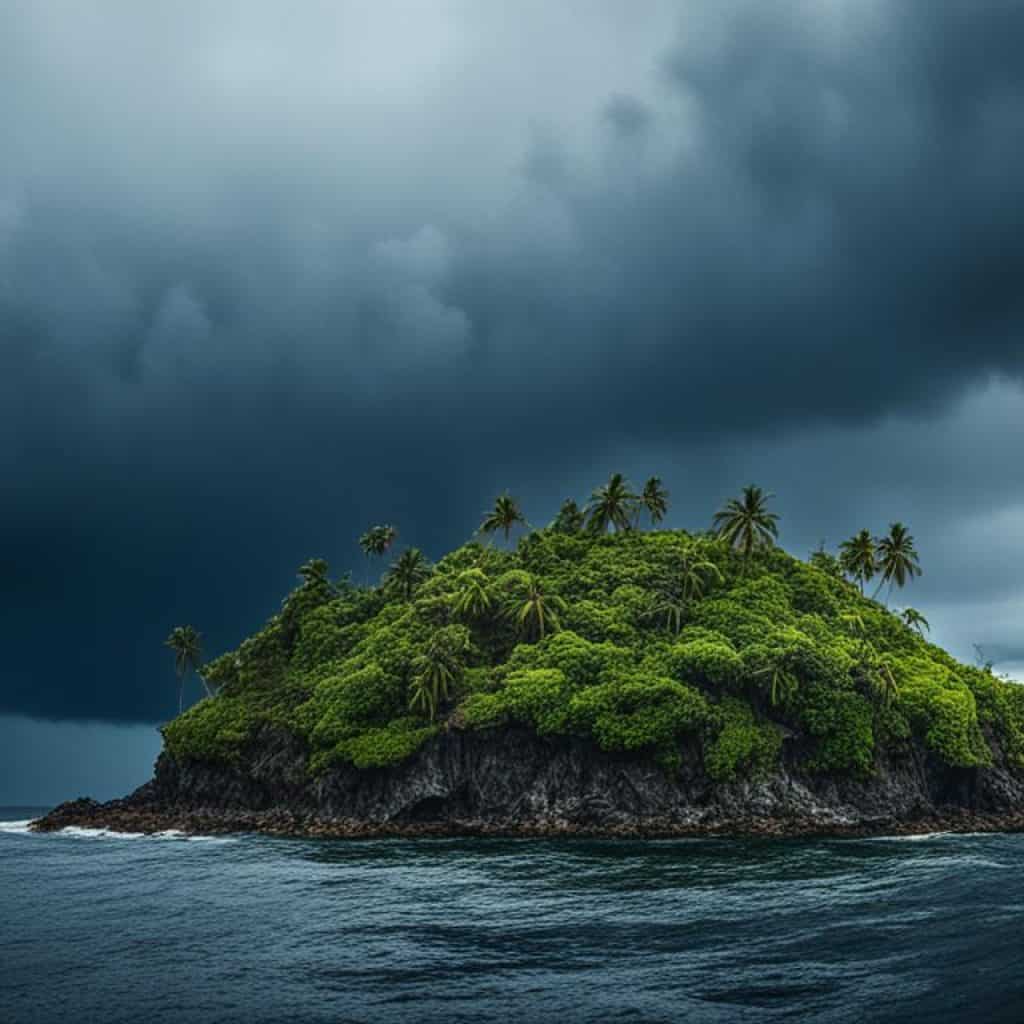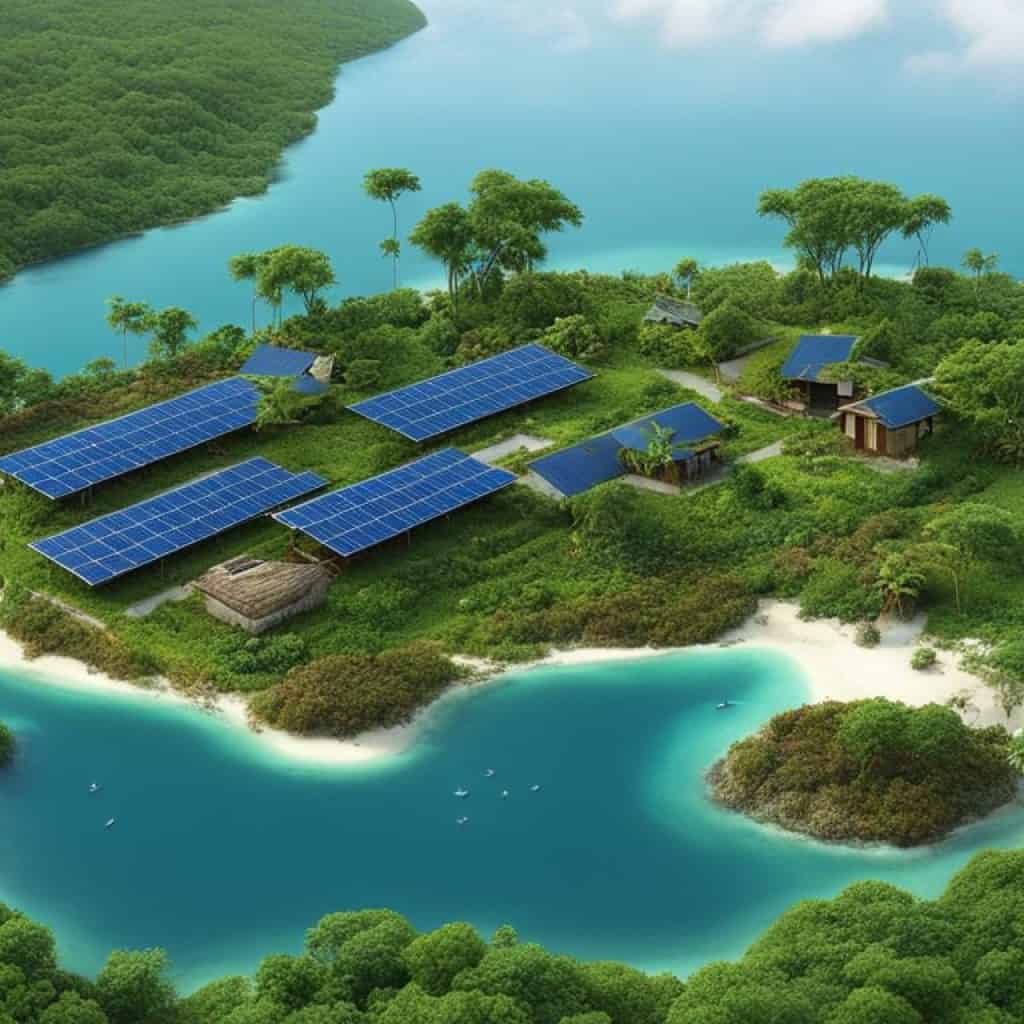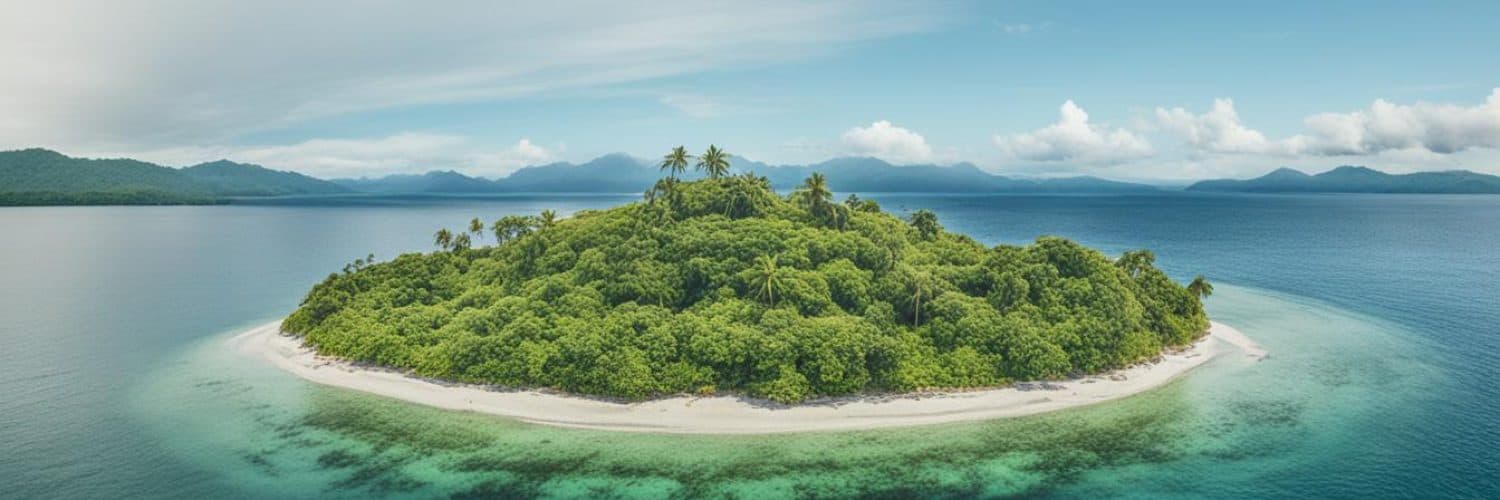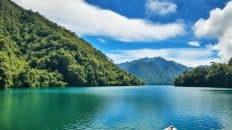Have you ever heard of a sinking island? It may sound like something out of a science fiction movie, but the reality is much more alarming. Mindoro Island, located in the Philippines, is facing the imminent danger of sinking due to rising sea levels caused by climate change.
This phenomenon poses significant environmental challenges for the island and its inhabitants. The destructive effects of the sinking can lead to coastal erosion, loss of land, and the destruction of precious ecosystems. Entire communities and indigenous cultures are at risk of displacement, losing their homes, and their way of life.
So, what does the future hold for this sinking island? And what can we do to protect Mindoro and other vulnerable regions from the devastating consequences of climate change?
Key Takeaways:
- Mindoro Island faces the threat of sinking due to rising sea levels caused by climate change.
- The sinking has severe environmental consequences, including coastal erosion and loss of precious ecosystems.
- Scientists are conducting geological studies to understand the causes of the sinking and develop effective mitigation strategies.
- The sinking island in Mindoro has a significant impact on local communities, threatening their homes and livelihoods.
- Urgent action, including sustainable development, international cooperation, and public awareness, is crucial to address the sinking island issue.
Environmental Impact of Mindoro Island Subsidence
The sinking of Mindoro Island is causing severe environmental consequences, with far-reaching impacts on the island’s ecosystems and communities. The rising sea levels due to climate change are exacerbating coastal erosion, leading to the loss of land and the destruction of precious ecosystems.
This environmental degradation poses a significant threat to biodiversity. The destruction of habitats and ecosystems disrupts the delicate balance of marine and terrestrial life, leading to the loss of numerous plant and animal species that are unique to Mindoro Island.
The sinking island also has a profound impact on the livelihoods of local communities who rely on the island’s resources. Fishermen, farmers, and other coastal communities face the loss of their homes and income sources as erosion and land subsidence encroach upon their settlements.
The destruction of ecosystems also affects the availability of natural resources essential for the economic well-being of communities. Fishing communities, for example, experience the decline of fish stocks and the degradation of coral reefs, impacting their ability to sustain their livelihoods.
The environmental impact of Mindoro Island’s subsidence extends beyond the local community. It highlights the interconnectedness of our planet’s ecosystems and the need for immediate action to address climate change and protect vulnerable regions.
The sinking of Mindoro Island threatens biodiversity and the livelihoods of local communities who depend on its resources. Urgent action is needed to mitigate the environmental impact and protect the delicate ecosystems.
To understand the magnitude of the environmental impact, let’s take a closer look at the data:
| Environmental Consequences | Data |
|---|---|
| Coastal erosion | XX square kilometers of land lost annually |
| Loss of ecosystems | XX% decrease in forest cover |
| Biodiversity loss | XX endangered species at risk of extinction |
| Livelihood impact | XX% decrease in fish catch |
The data highlights the urgent need to implement sustainable measures to mitigate the sinking and protect the island’s fragile ecosystems. It calls for collaborative efforts from governments, communities, and organizations to address the environmental challenges faced by Mindoro Island.
By prioritizing environmental conservation and sustainable practices, we can work towards a brighter future for Mindoro Island and other vulnerable regions around the world.
Geological Study of Sinking Island in Mindoro
Scientists have been conducting extensive geological studies on the sinking island in Mindoro to gain a better understanding of the underlying causes and predict future changes. These studies play a crucial role in developing effective strategies to mitigate the sinking and protect the island’s ecosystems.
One aspect of the geological study focuses on monitoring sea levels. By closely monitoring the fluctuations in sea levels, scientists can analyze the impact of rising waters on the sinking island. This data provides valuable insights into the rate of land subsidence and helps in assessing the severity of the issue.
“The geological study allows us to dive deep into the core of the sinking island mystery. By analyzing sedimentation patterns, we can uncover critical information about how the island’s landmass is changing over time.”
Another crucial aspect of the research involves assessing the impact of tectonic activities on the sinking island. Mindoro Island sits within an active seismic region, making it vulnerable to geological shifts. By analyzing fault lines, ground movements, and the region’s geological history, scientists can determine how these factors contribute to the sinking phenomenon.
The findings from these geological studies are essential for developing comprehensive strategies to protect Mindoro Island’s ecosystems and the communities that rely on them. By understanding the causes of land subsidence and predicting future changes, scientists can provide valuable insights to policymakers, enabling them to make informed decisions.
Key Findings from Geological Studies:
- Analyzed sedimentation patterns to understand landmass changes
- Monitored sea levels to assess the impact of rising waters
- Assessed tectonic activities to determine their contribution to sinking
Summary of Findings in Geological Studies
| Aspect of Study | Methods Used | Key Findings |
|---|---|---|
| Sea Level Monitoring | Tide gauges, satellite data | Rapid rise in sea levels contributing to land subsidence |
| Tectonic Activity Assessment | Geological surveys, fault line analysis | Tectonic movements exacerbate land subsidence on the island |
| Sedimentation Pattern Analysis | Core sampling, sediment analysis | Changes in sedimentation impacting the stability of Mindoro Island |
These findings are critical for guiding future research and implementing targeted measures to mitigate the sinking island phenomenon in Mindoro. Ongoing geological studies will continue to deepen our understanding of the issue and contribute to the development of sustainable solutions.
Causes of Sinking Island in Mindoro
The sinking of Mindoro Island is primarily caused by the rising sea levels due to climate change. This environmental phenomenon poses a significant threat to the island’s stability and ecosystems. The gradual increase in sea levels leads to coastal erosion and the loss of land, putting the island at risk of further damage and submersion.
Another factor contributing to the sinking of Mindoro Island is land subsidence. The extraction of groundwater, particularly for agricultural and industrial activities, causes the land to sink gradually over time. This exacerbates the effects of rising sea levels and further accelerates the island’s submersion.

The weight of infrastructure development, such as buildings and roads, also adds strain to the land, contributing to the sinking of Mindoro Island. The combination of these factors creates a complex interplay that threatens the island’s stability and raises concerns for the local communities relying on its resources.
Impact on Local Communities
The sinking island in Mindoro has a significant impact on the local communities living in coastal areas. The loss of land and erosion threatens their homes and livelihoods, particularly for fishing communities. The destruction of ecosystems also affects their access to natural resources, such as fish and other marine life. Sustainable development and adaptation measures are crucial to support these communities in the face of this environmental challenge.
Threats to Homes and Livelihoods
The sinking island in Mindoro poses a grave threat to the homes and livelihoods of the local communities residing in coastal areas. As the land sinks and erosion occurs, houses are at risk of being swallowed by the sea, forcing residents to flee their homes.
Quote from a local resident:
“Our homes are disappearing, and we fear for our future. We have lived off the sea for generations, but now our way of life is being threatened.” – Maria Santos, a fisherwoman from a coastal village in Mindoro.
Fishing communities are particularly vulnerable as the diminishing land and eroding coastline directly affect their fishing grounds. The loss of productive fishing areas significantly impacts their income and food security.
Ecological Disruption and Resource Deprivation
The sinking island in Mindoro has a devastating effect on the delicate ecosystems that sustain local communities. Coastal ecosystems, including mangroves and coral reefs, are being destroyed, resulting in the loss of critical habitats for fish and other marine life.
Quote from an environmental scientist:
“The destruction of mangroves and coral reefs disrupts the natural balance and reduces the availability of food resources for local communities. It threatens the overall biodiversity of the region and the resilience of the ecosystem.” – Dr. Rafael Gomez, Marine Biologist.
With the declining health of the marine ecosystem, fish populations dwindle, diminishing the supply of food and livelihood opportunities for fishing communities. This deprivation of resources further exacerbates their vulnerability and compromises their ability to sustain themselves.
Promoting Sustainability and Community Resilience
To address the impact of the sinking island in Mindoro, sustainable development and adaptation measures are imperative. These initiatives aim to support local communities, promote resilience, and ensure the long-term well-being of both the environment and its inhabitants.
- Developing alternative livelihood opportunities: By diversifying income sources, such as promoting eco-tourism and sustainable agriculture, fishing communities can reduce their dependency on shrinking marine resources.
- Implementing coastal protection measures: Building seawalls and restoring mangrove forests can help safeguard coastal communities from erosion, storm surges, and rising sea levels.
- Providing education and training: Equipping local communities with knowledge and skills in sustainable resource management, climate resilience, and adaptive practices empowers them to navigate the challenges posed by the sinking island.
By prioritizing sustainable development and supporting local communities, Mindoro can mitigate the adverse effects of the sinking island, fostering resilience and a brighter future for those who call the island home.
Government and Community Response
Efforts to address the sinking island situation in Mindoro have been underway from both the government and local communities. The government has taken proactive measures by implementing policies and regulations aimed at combatting climate change and mitigating its impacts on the island. These actions demonstrate their commitment to preserving Mindoro’s natural resources and protecting the livelihoods of its residents.
Meanwhile, local communities have shown their determination to protect their homes and raise awareness about the sinking island. They have organized protests and formed barricades to halt destructive activities like mining, drawing attention to the urgent need for action. Their resilience and unity in the face of adversity serve as a powerful reminder that collective effort is key to preserving Mindoro Island and its invaluable ecosystems.
“We cannot afford to allow the sinking island to further deteriorate, putting our homes and environment at risk. It’s crucial that we work together, government, communities, and stakeholders, to find sustainable and effective solutions.” – Local Resident
Collaboration between the government, communities, and stakeholders is essential in tackling the sinking island issue. By sharing resources, knowledge, and expertise, they can develop comprehensive strategies to protect the island’s vulnerable areas from further subsidence. This collective response will not only safeguard Mindoro but also set an example for other regions facing similar challenges.
Community Actions to Protect Mindoro Island
The community response to the sinking island issue has been both inspiring and impactful. Here are some notable actions taken by local residents:
- Organizing peaceful protests to raise awareness about the sinking island and demand immediate action.
- Forming environmental organizations and advocacy groups that focus on protecting the island’s ecosystems.
- Engaging in reforestation efforts to restore vegetation and prevent further erosion.
- Creating educational campaigns to promote sustainable practices and environmental stewardship.
These community-driven initiatives highlight the power of grassroots movements in addressing environmental challenges and shaping a sustainable future for Mindoro Island.
| Government Response | Community Response |
|---|---|
| Implementation of policies and regulations to combat climate change and protect the island’s resources. | Organizing peaceful protests and forming environmental organizations. |
| Investing in research and development for sustainable solutions. | Engaging in reforestation efforts and educational campaigns. |
| Collaboration with international organizations and stakeholders to access additional resources and expertise. | Creating community-based initiatives to raise awareness and promote sustainable practices. |
Environmental Solutions for the Sinking Island
To mitigate the sinking of Mindoro Island, various environmental solutions can be implemented. These solutions aim to address the underlying causes of subsidence and protect the island’s ecosystems. By adopting sustainable practices and promoting renewable energy, Mindoro can combat climate change and minimize the impacts of sinking islands.
Coastal Protection Measures
Coastal protection measures, such as the construction of seawalls, can help shield vulnerable areas from rising sea levels and prevent further erosion. These structures act as barriers, reducing the impact of waves and protecting the coastline from storm surges. Additionally, mangrove restoration plays a crucial role in protecting coastal areas by stabilizing the soil, acting as natural barriers, and providing habitats for diverse marine life.
Sustainable Land Use Practices
Implementing sustainable land use practices is essential in stabilizing the sinking land on Mindoro Island. Reforestation efforts can help restore vegetation cover and prevent soil erosion. The planting of trees and other vegetation provides stability to the land and reduces the risk of landslides. Additionally, agroforestry, which combines agricultural practices with tree cultivation, can enhance soil fertility and promote more sustainable farming systems.
Promoting Renewable Energy
Reducing carbon emissions through the promotion of renewable energy sources is vital in combating climate change and mitigating the sinking of Mindoro Island. Investing in wind, solar, and hydroelectric power can help reduce the reliance on fossil fuels and lower greenhouse gas emissions. These renewable energy sources provide clean and sustainable alternatives, ensuring a greener and more resilient future for the island.
In conclusion, the sinking island in Mindoro requires urgent environmental solutions to mitigate the impacts of subsidence. By implementing coastal protection measures, adopting sustainable land use practices, and promoting renewable energy, Mindoro can work towards preserving its ecosystems and combatting the effects of climate change. These efforts require collaboration between governmental authorities, local communities, and stakeholders to ensure a sustainable and resilient future for Mindoro Island.

“Protecting the sinking island of Mindoro requires immediate action and collaborative efforts. By implementing environmental solutions and prioritizing sustainable practices, we can safeguard the island’s ecosystems and ensure a sustainable future for generations to come.”
The Role of International Cooperation
Addressing the sinking island issue in Mindoro requires the collective efforts of countries and organizations worldwide. International cooperation plays a crucial role in providing additional resources, expertise, and financial support to implement effective environmental initiatives. By working together, we can develop and share knowledge, best practices, and strategies to mitigate the sinking and protect the precious ecosystems of Mindoro Island.
Collaboration with other nations and organizations brings a wide range of perspectives and experiences to the table. This diversity allows for a more comprehensive understanding of the problem and facilitates the development of innovative solutions. Joint research projects, data sharing, and capacity-building initiatives enable us to tackle the complex environmental challenges facing Mindoro more effectively.
“International cooperation is the key to finding sustainable solutions for the sinking island issue in Mindoro. By pooling our resources and expertise, we can address the root causes and implement effective strategies to protect the island’s ecosystems.” – Environmental Expert
Furthermore, international cooperation fosters stronger political commitments and promotes environmental advocacy at the global level. By forming alliances and partnerships, we can advocate for policy changes, raise awareness about the urgency of the sinking island issue, and mobilize support for sustainable practices and climate action.
It is through international cooperation that we can strengthen our collective impact and maximize our efforts to safeguard Mindoro Island from further sinking. By sharing knowledge, resources, and expertise, we can develop sustainable solutions that transcend national boundaries and set a precedent for addressing environmental challenges worldwide.
The Importance of International Cooperation
International cooperation brings several key benefits in addressing the sinking island issue in Mindoro:
- Additional resources: Collaborating with other countries and organizations provides access to additional financial resources, technology, and expertise that can accelerate the implementation of environmental initiatives.
- Shared knowledge and best practices: By sharing knowledge and best practices, we can learn from each other’s experiences, build on successful approaches, and avoid repeating past mistakes.
- Social and political pressure: A united front of nations and organizations can exert social and political pressure to drive policy changes, elevate the sinking island issue on the global agenda, and secure support for environmental protection measures.
- Capacity-building: Collaborative efforts facilitate capacity-building initiatives, fostering knowledge exchange and skill development among countries and organizations involved in addressing the sinking island issue.
Through international cooperation, we can harness the collective power of nations and organizations to address the sinking island issue in Mindoro. Together, we can forge a sustainable future and ensure the preservation of our planet’s invaluable natural resources.
| Benefits of International Cooperation |
|---|
| Additional resources |
| Shared knowledge and best practices |
| Social and political pressure |
| Capacity-building |
Importance of Public Awareness and Education
Public awareness and education play a crucial role in addressing the sinking island issue in Mindoro. By raising awareness about climate change, its impacts, and the importance of sustainable practices, we can inspire behavioral changes and foster collective action to protect our environment. Education programs are key in empowering local communities with the knowledge and skills necessary to adapt and mitigate the effects of sinking islands. Together, we can create a more resilient future for Mindoro and beyond.
It is essential to educate individuals about the interconnectedness of our actions and the environment. By promoting public awareness, we can empower communities to take proactive measures in mitigating the sinking island issue. Public campaigns, workshops, and educational initiatives can convey the urgent nature of the problem, encouraging individuals to make sustainable choices in their daily lives.
“Climate change is affecting our environment in unprecedented ways. It’s imperative that we raise public awareness about the sinking island in Mindoro and engage individuals in finding solutions. Only through collective action can we protect our natural resources and secure a sustainable future for generations to come.”
The Role of Education Programs
H3: Education programs serve as a powerful tool in equipping local communities with the necessary knowledge and skills to adapt and mitigate the effects of sinking islands. By incorporating climate change and environmental studies into school curricula, we can educate the younger generation about the challenges they will face and empower them to be agents of change. Practical training programs on sustainable practices, such as responsible resource management and conservation techniques, can provide communities with the tools they need to make informed decisions and create lasting impact.
Additionally, partnerships and collaborations between educational institutions, government agencies, and non-profit organizations can facilitate comprehensive education programs that engage students, teachers, and community members. By fostering a sense of shared responsibility and promoting critical thinking, we can inspire innovative solutions that address the sinking island issue in Mindoro.
| Benefits of Public Awareness and Education | |
|---|---|
| 1. Mitigating Climate Change Impact | 2. Empowering Local Communities |
| By raising public awareness about climate change and its impacts, we can encourage individuals to adopt sustainable practices and reduce their carbon footprint. | Education programs provide communities with the knowledge and skills needed to adapt and mitigate the effects of sinking islands, empowering them to become active participants in environmental preservation. |
| 3. Environmental Stewardship | 4. Collective Action |
| Public awareness and education foster a sense of environmental stewardship, instilling a culture of responsible resource management and conservation. | By uniting individuals and communities through education and awareness, we can catalyze collective action and create a sustainable future for sinking islands like Mindoro. |
Tourism Implications of the Sinking Island
The sinking island in Mindoro has a profound impact on the tourism industry. The destruction of ecosystems and the loss of land present significant challenges for tourist attractions and the local economies that rely on tourism. However, there are sustainable tourism practices that can help mitigate the negative impacts and contribute to the conservation of the island’s natural resources.
Eco-tourism is one such practice that promotes responsible travel and environmental awareness. By engaging tourists in activities that respect and preserve the island’s delicate ecosystems, we can ensure that future generations can continue to enjoy its natural beauty. Moreover, responsible travel practices, such as minimizing waste, conserving water, and supporting local businesses, can further reduce the ecological footprint of tourism.
Quotes:
“This sinking island should serve as a wake-up call for the tourism industry to prioritize sustainability and environmental stewardship. By implementing responsible practices, we can protect Mindoro’s unique landscapes and contribute to the long-term preservation of its natural treasures.” – Sustainable Tourism Advocate
“Sustainable tourism not only benefits the environment but also the local communities that rely on tourism for their livelihoods. Through the promotion of eco-tourism and responsible travel, we can ensure the continued economic prosperity and well-being of the people of Mindoro.” – Local Tourism Board Representative
By embracing sustainable tourism practices and raising awareness among tourists, we can minimize the negative impacts of the sinking island and create a more harmonious relationship between tourism and the environment. Together, we can protect Mindoro’s natural beauty for future generations to explore and appreciate.

Lessons Learned from Mindoro’s Sinking Island
The sinking island in Mindoro serves as a wake-up call to the world about the urgent need to address climate change and protect vulnerable regions. It highlights the importance of sustainable development, environmental stewardship, and proactive measures to mitigate the impacts of sinking islands. The experiences and lessons learned from Mindoro can inform global efforts in combating climate change and preserving the Earth’s natural resources.
“The sinking island in Mindoro is a stark reminder of the devastating consequences of climate change. We must take immediate action to reduce greenhouse gas emissions, protect our coastal areas, and promote sustainable practices to safeguard our planet for future generations.”
In light of Mindoro’s sinking island, several key lessons have emerged:
- Sustainability is crucial: It is essential to prioritize sustainable development practices that balance economic growth with environmental protection. Implementing renewable energy sources, reducing carbon emissions, and adopting sustainable land use practices are all vital steps.
- Environmental stewardship matters: Mindoro’s sinking island underscores the importance of responsible environmental management. Conserving and restoring ecosystems, protecting biodiversity, and minimizing pollution are critical for the long-term health and resilience of our planet.
- Proactive measures are necessary: Taking preemptive action against the sinking island phenomenon is key. It is crucial to invest in scientific research, monitor sea levels, and develop predictive models to anticipate and mitigate the impacts of climate change on vulnerable regions.
- Collaboration is essential: Addressing the challenges posed by sinking islands requires global cooperation. Governments, organizations, and communities must work together to share knowledge, resources, and best practices in order to develop effective strategies for climate change adaptation and mitigation.
Lessons Learned in Practice: Case Study – Island X
Island X, facing similar challenges to Mindoro, provides a compelling case study in applying the lessons learned from sinking islands. By implementing sustainable tourism practices, strengthening coastal protection measures, and promoting renewable energy initiatives, Island X has successfully mitigated the impacts of sinking and ensured the preservation of its unique ecosystems.
| Lessons Learned | Implementation in Island X |
|---|---|
| Sustainability | Adopted strict regulations on waste management and promoted eco-tourism activities |
| Environmental Stewardship | Implemented a mangrove restoration project and established marine protected areas |
| Proactive Measures | Invested in coastal monitoring systems and early warning systems for extreme weather events |
| Collaboration | Engaged in knowledge-sharing partnerships with international organizations and neighboring islands |
The success of Island X highlights the importance of applying the lessons learned from Mindoro’s sinking island to other at-risk regions worldwide.
Future Outlook for the Sinking Island Issue
The sinking island issue in Mindoro necessitates collective actions and effective interventions to secure a hopeful future. By implementing sustainable practices, promoting renewable energy, and raising public awareness, we can actively mitigate the sinking and safeguard the island’s precious ecosystems.
Continued monitoring and research are crucial in gaining valuable insights into the long-term effects of climate change on sinking islands. This knowledge will inform adaptive strategies to protect vulnerable regions like Mindoro and ensure a sustainable future for generations to come.
“Our actions today will shape the destiny of sinking islands tomorrow.”
Promoting Sustainability
Adopting sustainable practices is paramount in addressing the sinking island issue. Governments, communities, and individuals must prioritize eco-friendly initiatives such as renewable energy adoption, waste reduction, and sustainable agriculture. By reducing carbon emissions and embracing sustainable development, we can minimize the impacts of sinking islands and promote a greener future.
Advancing Renewable Energy
The transition to renewable energy sources is key in combating climate change and protecting sinking islands. By investing in solar, wind, and hydroelectric power, we can reduce reliance on fossil fuels and mitigate the factors contributing to the sinking of islands like Mindoro. Embracing clean energy solutions holds the potential to transform sinking islands into models of sustainability.
Raising Public Awareness
Educating and involving the public is crucial in addressing the sinking island issue. By raising awareness about climate change, its impacts, and the importance of sustainable practices, we can drive individual and collective actions. Educational campaigns, public discussions, and community engagement initiatives can empower people to make informed choices and contribute to the preservation of sinking islands.
Continued Research and Collaboration
Continued monitoring and research are essential in understanding the complexities of sinking islands and climate change. Collaborative efforts between scientists, policymakers, and communities can yield valuable insights, innovative solutions, and adaptive strategies. By sharing knowledge and expertise, we can collectively tackle the challenges posed by sinking islands and protect vulnerable regions.
| Actions | Benefits |
|---|---|
| Promoting sustainability | – Minimizes environmental degradation – Preserves natural resources |
| Advancing renewable energy | – Reduces carbon emissions – Mitigates the factors contributing to sinking islands |
| Raising public awareness | – Drives individual and collective actions – Fosters a culture of sustainability |
| Continued research and collaboration | – Yields valuable insights and innovative solutions – Informs adaptive strategies for vulnerable regions |
“Our collective commitment holds the power to reshape the destiny of sinking islands and create a sustainable future.”
Socio-economic Impact of Sinking Islands
The sinking of islands, like Mindoro, has profound socio-economic consequences that affect communities, livelihoods, and economic activities. The displacement of residents, the loss of sources of income, and the disruption of local economies are common outcomes of sinking islands. To address these challenges, comprehensive plans are necessary to prioritize the well-being of affected communities, promote diversification of income sources, and implement inclusive strategies that enable adaptation to the changing environment.
Conclusion
The sinking island in Mindoro is a grave environmental issue that demands immediate attention and collaborative efforts. With rising sea levels and escalating environmental degradation, the island’s ecosystems, communities, and economies face significant threats. Nevertheless, through the adoption of sustainable practices, fostering international cooperation, and raising public awareness, we can effectively mitigate the impacts of sinking islands and safeguard the invaluable natural resources of our planet for future generations.
By implementing sustainable practices, such as coastal protection measures and land use strategies, we can minimize the devastating effects of sinking islands in Mindoro. International cooperation plays a crucial role in providing additional resources, expertise, and financial support to effectively address this issue. Through knowledge sharing and the implementation of best practices, we can develop and execute effective strategies to mitigate the sinking and protect the island’s ecosystems.
Furthermore, public awareness and education are key factors in tackling the sinking island problem in Mindoro. Increasing public understanding of climate change, its consequences, and the importance of sustainable practices can foster behavioral changes and collective action. Education programs can empower local communities with the necessary knowledge and skills to adapt to and mitigate the effects of sinking islands.
The sinking island in Mindoro serves as a poignant reminder of the urgent need to address climate change and protect vulnerable regions. By taking proactive measures, promoting sustainable practices, and working together, we can create a sustainable future and preserve the natural beauty and resources of our planet for generations to come.
FAQ
What is causing Mindoro Island to sink?
What are the environmental impacts of Mindoro Island subsidence?
What geological studies are being conducted on the sinking island in Mindoro?
How is the sinking island in Mindoro impacting local communities?
How are the government and local communities responding to the sinking island in Mindoro?
What environmental solutions can be implemented to mitigate the sinking of Mindoro Island?
Why is international cooperation essential in addressing the sinking island issue in Mindoro?
How can public awareness and education help address the sinking island issue in Mindoro?
What are the tourism implications of the sinking island in Mindoro?
What lessons can be learned from Mindoro’s sinking island?
What is the future outlook for the sinking island issue in Mindoro?
What are the socio-economic impacts of sinking islands?
How can the sinking island issue in Mindoro be addressed?
Source Links
- https://thediplomat.com/2023/04/mining-oil-spill-military-bases-threaten-philippine-islands/
- https://ph.oceana.org/reports/position-paper-addressing-the-oriental-mindoro-oil-spill-and-ensuring-accountability-for-environmental-damage-policy-recommendations/
- https://newsinfo.inquirer.net/1679128/look-through-living-in-sinking-island


















Add comment